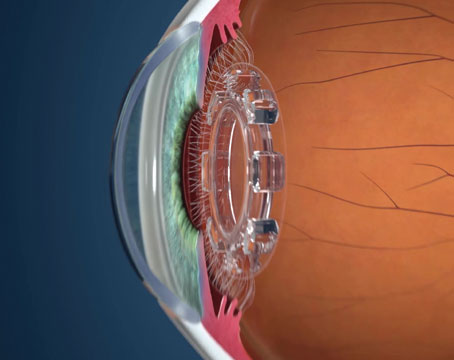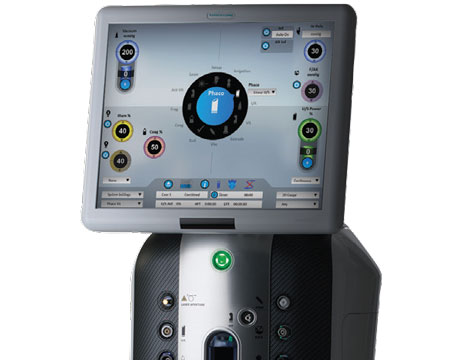In conductive keratoplasty, performed using the ViewPoint CK system from Refractec (
Evolution
Since the introduction of the original CK procedure, several refinements have been developed. The variability of the original procedure's results was diminished significantly when Rick Milne, MD, in private practice at the
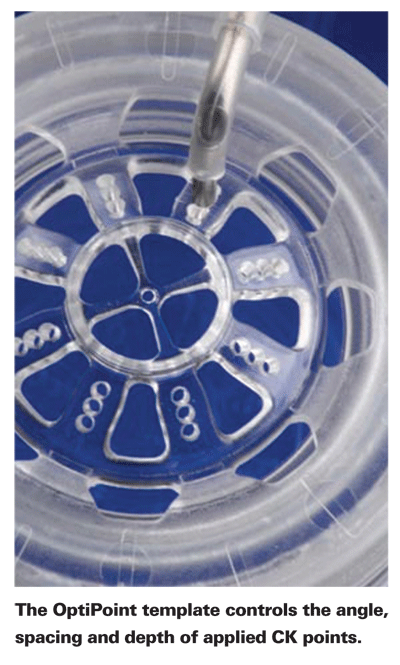
More recently, in April of this year, Refractec introduced the CK OptiPoint template. The template is placed on the eye, where its guideholes ensure accurate centration and spacing of the application points, helping to prevent induction of cylinder. At the same time, the template keeps the surgeon from applying excess pressure and ensures that the tip enters perpendicularly every time and reaches the same depth. The device, which has FDA 510k approval, includes a suction ring to help maintain its position on the eye as one point after another is applied. The suction also helps to prevent the cornea from retreating under the pressure of the probe insertion.
Clinical Impact
Dr. Milne has used the OptiPoint template as part of an ongoing clinical trial involving 124 eyes of 124 subjects. "Outcomes are now very consistent because we're doing a very reproducible procedure," he says. "When Dan Durrie and I did a large CK trial together in the past our outcomes were always about 0.25 D apart. With the template, we're within 0.01 D of each other at six months. This is extreme reproducibility. Furthermore, the three, six and nine-month data show that this gives a more stable, lasting result than the LightTouch method produced. In addition, the patients have had no complications, no change in contrast sensitivity, minimum induction of cylinder, and distance vision was preserved."
Elaborating on the differences between the three variations (the original approach, LightTouch and using the template), Dr. Milne explains that the original technique produced less effect but the change was relatively stable—about as stable as hyperopic laser treatment. "We noticed an 18-percent loss of effect from one month to three months, which is very similar to what you get with the laser, according to the FDA presbyopic and hyperopic trials involving more than 400 eyes," he says. "It then stabilized from three to six months, much like laser treatment. 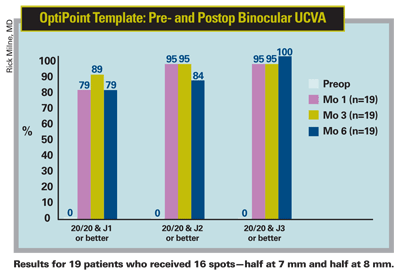
"In contrast, LightTouch gave a more robust effect initially, but the benefits diminished more rapidly during the first year," he continues. "The reason is most likely that the corneal tissue was retracting away from the probe during the pulse. Unless you maintain the depth during the pulse, you end up with a shallow treatment, a smaller functional optical zone and more regression.
"With the new template, the suction device increases the pressure inside the eye so the cornea doesn't retract away from the probe," he notes. "You stay at full depth throughout the whole pulse. At the same time, the template ensures consistent pressure is applied at every spot. So, you're using more pressure than you did with LightTouch—although it's still less than with the original procedure—and you're doing it more consistently.
"The difference in the effect on the tissue is visible in electro-micrographs," he adds. [See below]. "LightTouch produced a more parabolic effect that diminished toward the endothelium. In contrast, when we use the template, the effect is even all the way to the endothelium. This produces a stronger band of tension around the cornea, and less regression as a result."
A Different Experience
Dr. Milne notes that although using the template doesn't reduce the time required to perform the procedure, it makes it much simpler and easier for the surgeon; it eliminates the pressure of wondering whether you're doing it correctly. "The template lets every surgeon do a great job every time," he says. "It eliminates concerns about pressing too hard or too lightly, pulling out too quickly, inserting the probe perpendicularly and being centered. Plus, the cornea doesn't pull away from you during the treatment. Each spot is very uniform and full thickness. It becomes a very simple, reproducible procedure."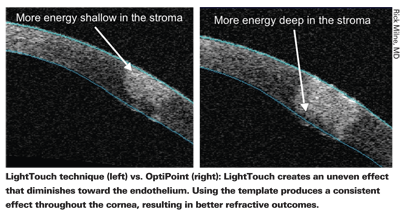
Dr. Milne says using the template makes the procedure easier on the patient as well. "The patient doesn't have to worry about holding his eye still," he explains. "The template holds it in place. It also dims the patient's vision a little so he doesn't see the probe coming toward his eye."
For more information about the OptiPoint corneal template or the CK procedure, visit Refractec.com on the Web.
